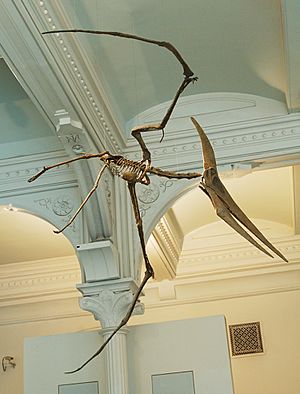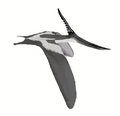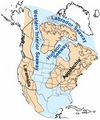Pteranodon facts for kids
Quick facts for kids Pteranodon |
|
|---|---|
 |
|
| Mounted replica of an adult male P. longiceps skeleton, AMNH | |
| Scientific classification |
|
| Kingdom: | Animalia |
| Phylum: | Chordata |
| Order: | †Pterosauria |
| Suborder: | †Pterodactyloidea |
| Family: | †Pteranodontidae |
| Subfamily: | †Pteranodontinae Marsh, 1876 |
| Genus: | †Pteranodon |
| Type species | |
| †Pteranodon longiceps Marsh, 1876
|
|
| Other species | |
|
|
| Synonyms | |
|
|
Pteranodon was a large pterosaur from the Upper Cretaceous period. About 1200 partial skeletons have been found, more than any other pterosaur. It lived in the area of the Western Interior Seaway.
Fossil Pteranodon have been found in Kansas, Alabama, Nebraska, Wyoming, and South Dakota.
Contents
Appearance
With its wings open it was up to 6.25 meters across. Pteranodon might have lived much like an albatross, spending a lot of time over the ocean, looking for fish. It had no teeth in its long mouth, and it had a small pouch like a pelican at the back of its jaw. Pteranodon had a big crest at the back of its head. Pteranodon longiceps had a straight crest that went backwards, and Pteranodon sternbergi had a bigger, flatter crest that went upward.
Life style
Pteranodon lived mainly on offshore rookeries. Most Pteranodon fossils are found where, at the time, they were hundreds of kilometres from the coastline.
They certainly fed on fish. Fossilized fish bones have been found in the stomach area of one Pteranodon. Other specimens have fragments of fish scales and vertebrae near the torso.
Females of both species were smaller than the males, and had small, rounded crests. The crests were probably used in display, though they may have had other functions as well.
Images for kids
-
Map of North America during the mid-Cretaceous period, illustrating the Western Interior Seaway (middle to upper left) and other nearby seaways
-
Skeleton of P. longiceps, in launch pose, Telus World of Science, Vancouver
See also
 In Spanish: Pteranodon para niños
In Spanish: Pteranodon para niños













